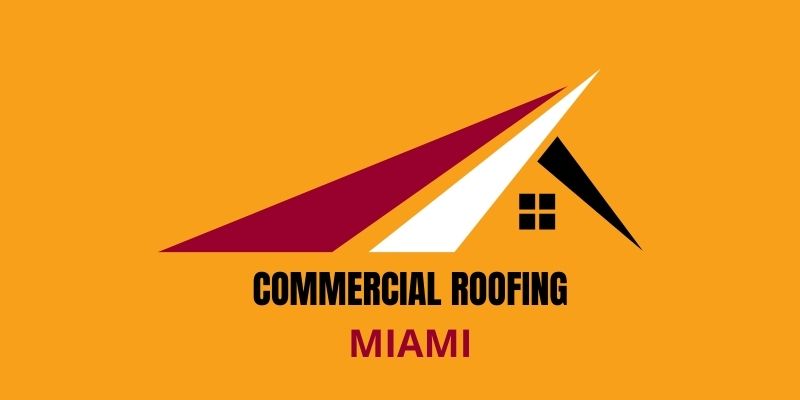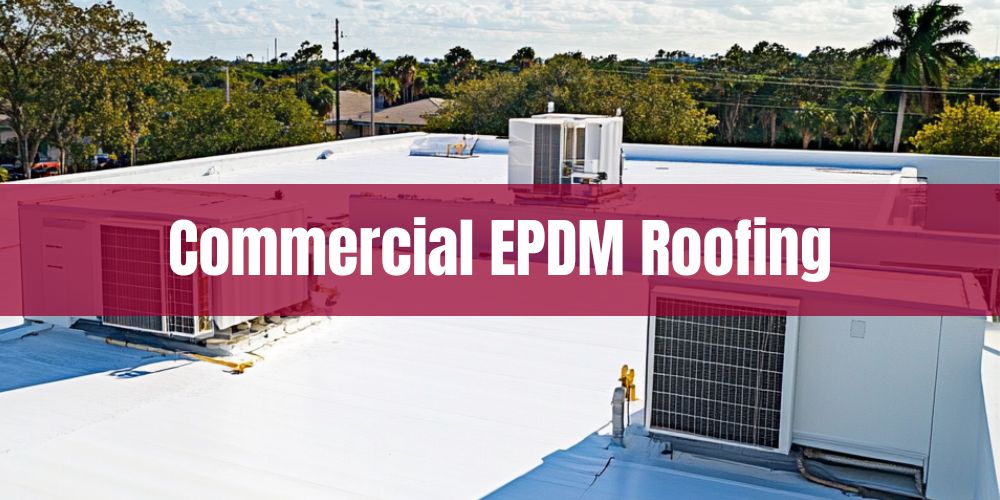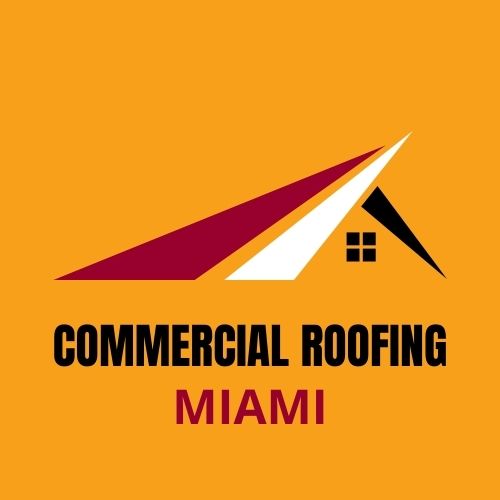Commercial EPDM roofing involves the installation, repair, and maintenance of EPDM roofing systems specifically on commercial buildings. EPDM, standing for ethylene propylene diene monomer, is a durable synthetic rubber membrane often used for low-slope roofs due to its excellent water resistance and flexibility. This type of roofing is ideal for commercial properties, ensuring long-term protection against various weather conditions while offering energy efficiency benefits. Commercial EPDM roofing systems are lightweight, easy to install, and can effectively lower maintenance costs over the lifespan of the roof. Commercial Roofing Miami provide commercial EPDM roofing services across the Miami, Florida area.
What Is Commercial EPDM Roofing?
EPDM (Ethylene Propylene Diene Monomer) roofing is a type of synthetic rubber membrane that is widely used in commercial roofing systems due to its durability, flexibility, and weather resistance. It is typically used on low-slope commercial buildings and is known for its outstanding ability to withstand extreme weather conditions, such as high winds, heavy rains, and intense UV exposure. EPDM roofs are available in both black and white, with the white version reflecting sunlight to help reduce energy costs. Installation methods for EPDM roofing include fully adhered, mechanically attached, and ballasted techniques, which provide various benefits in terms of longevity and performance. The material is also known for being environmentally friendly, as it is recyclable and has a long lifespan, reducing the frequency of re-roofing and waste. In addition, its seamless appearance offers a sleek aesthetic while minimizing the risk of leaks and water infiltration.
Miami, Florida's tropical climate, characterized by high humidity and frequent heavy rainfall, makes EPDM roofing an ideal choice for commercial buildings, due to its superior resistance to moisture and UV damage. The installation of EPDM roofs in Miami often emphasizes the fully adhered method to ensure a strong bond and adapt to the region's high wind conditions, providing improved protection against weather-related damage.
Have a question about an upcoming project?
What Are The Advantages Of EPDM Roofing In Miami?
EPDM roofing offers excellent weather resistance, energy efficiency, and longevity, making it ideal for Miami's climate. Considering Miami's warm and humid environment, EPDM roofing is particularly advantageous due to its durability and reflective properties. It provides cost-effective solutions while maintaining the structural integrity of buildings amidst frequent rains and high temperatures.
- Weather Resistance: Effectively withstands Miami's intense storms and frequent rainfalls.
- Energy Efficiency: Reflects UV rays, reducing cooling costs in Miami's hot climate.
- Durability: Offers a long lifespan with minimal maintenance in Miami's warm conditions.
- Flexibility: Adapts well to Miami's temperature fluctuations without cracking.
- Cost-Effectiveness: Provides affordable initial installation and long-term savings.
1. Weather Resistance: Effectively withstands Miami's intense storms and frequent rainfalls.
Weather resistance refers to a roofing material's ability to endure harsh weather conditions, such as strong winds, heavy rainfalls, and storms, without experiencing damage or performance degradation. For commercial roofing in Miami, weather resistance is paramount due to the city's susceptibility to hurricanes and tropical storms. EPDM roofing offers robust weatherproof qualities, making it particularly advantageous for buildings in Miami's challenging climate. The durability of EPDM roofing ensures continuous protection and reduces the risk of leaks during intense weather events.
Enhancing the weather resistance of EPDM roofs can be achieved by incorporating additional sealing measures and regular maintenance checks. Proactive inspections after significant weather events allow for early detection of potential vulnerabilities, ensuring that the roofing system remains intact and functional. Investing in a high-quality installation and routine upkeep can significantly extend the lifespan of the roofing system, providing long-term cost-effectiveness and safety for commercial properties.
2. Energy Efficiency: Reflects UV rays, reducing cooling costs in Miami's hot climate.
Energy efficiency is the ability of a roofing material or system to reduce energy consumption, such as cooling costs, by reflecting rather than absorbing heat. This capability is crucial for EPDM roofing in Miami, where the tropical climate demands high performance from cooling systems. By reflecting UV rays, EPDM roofing reduces the heat load on buildings, significantly lowering air conditioning costs and maintaining indoor comfort.
The use of energy-efficient roofing materials like EPDM contributes not only to immediate cost savings but also to long-term financial benefits through reduced energy bills. Additionally, EPDM's reflective properties help mitigate the urban heat island effect, making it an environmentally sustainable option for commercial buildings. Maintenance of these reflective surfaces ensures their effectiveness, preserving their benefits over the roof's lifespan.
3. Durability: Offers a long lifespan with minimal maintenance in Miami's warm conditions.
Durability refers to the capacity of a commercial roofing system to endure the warm weather conditions of Miami while requiring minimal maintenance to preserve its structural integrity. Durability is a key advantage of EPDM roofing in Miami due to its exceptional resistance to thermal cycling and heat, which are prevalent in the region. EPDM's rubber-like elasticity allows it to expand and contract without cracking, making it ideal for resisting the stress of Miami's environmental conditions.
By choosing a durable material like EPDM, commercial properties in Miami can benefit from reduced maintenance costs and a prolonged roof lifespan. Additionally, the low maintenance requirements of EPDM roofing systems result in fewer disruptions and lower long-term repair expenses. To maximize durability, regular inspections and prompt repair of minor issues are recommended to ensure EPDM roofs perform optimally under Miami's warm climate conditions.
4. Flexibility: Adapts well to Miami's temperature fluctuations without cracking.
Flexibility refers to a roofing material's ability to withstand temperature changes and environmental stressors without experiencing structural damage such as cracking. In Miami, where temperature fluctuations can be significant, having a flexible roofing system like EPDM is advantageous because it can adjust to these changes without compromising its integrity. This adaptability helps maintain the roof's waterproofing capabilities, ensuring protection against Miami’s frequent rainfalls.
EPDM roofing is designed to maintain its suppleness across a wide temperature range, making it ideal for areas where weather conditions can shift unexpectedly. To further enhance its durability, property managers can schedule regular maintenance checks to observe the roof's condition and perform minor repairs if needed. This proactive approach extends the roof’s lifespan, providing long-term economic benefits to commercial buildings in Miami.
5. Cost-Effectiveness: Provides affordable initial installation and long-term savings.
Cost-effectiveness in commercial roofing refers to the ability of a roofing solution to be economically advantageous by offering low initial installation costs and reducing overall expenses through durable performance and minimal maintenance. Cost-effectiveness benefits EPDM roofing in Miami by providing an attractive upfront cost coupled with reduced long-term maintenance expenses, an ideal feature in a city prone to fluctuating weather patterns. Its superior durability ensures fewer repairs over time, contributing to significant savings in both materials and labor.
EPDM's reflective properties also play a crucial role in lowering cooling costs, which is particularly beneficial given Miami’s warm climate that places a high demand on air conditioning systems. By minimizing heat absorption, EPDM roofing reduces energy consumption, facilitating long-term savings on utility bills. Routine maintenance, combined with its inherent robust nature, ensures that EPDM roofing remains a financially sound investment for commercial properties in Miami.
How Does Miami's Climate Affect EPDM Roofing Performance?
Miami's climate, characterized by high humidity, intense UV exposure, and frequent storms, can challenge EPDM roofing. These conditions require the material to be resistant to both moisture accumulation and thermal expansion. Proper installation and maintenance can help maximize its lifespan and efficiency in this environment.
- UV Resistance: Essential for withstanding Miami's intense and prolonged UV ray exposure.
- Moisture Resistance: Must prevent water absorption during Miami's frequent thunderstorms and high humidity.
- Thermal Expansion Tolerance: Adjusts well to Miami's intense temperature fluctuations.
- Maintenance Needs: Regular inspections necessary due to Miami's challenging weather conditions.
- Longevity: Proper care extends lifespan despite Miami’s harsh climate conditions.
1. UV Resistance: Essential for withstanding Miami's intense and prolonged UV ray exposure
UV resistance refers to a roofing material's ability to withstand damage from sun exposure, preventing degradation and extending its lifespan. Miami's powerful and persistent sunlight significantly affects EPDM roofing by causing the material to break down if it lacks proper UV protection. High UV resistance in commercial roofing ensures that these surfaces maintain their integrity despite the relentless heat and sunlight typical of Miami's climate.
For commercial roofs in Miami, utilizing UV-resistant coatings can greatly mitigate the effects of intense sun exposure. Frequent maintenance and inspections are crucial to assessing any potential UV damage, enabling timely interventions that can bolster the roof's durability and performance. By choosing materials with high UV resistance, businesses can preserve the roof’s functionality and reduce maintenance costs over time.
2. Moisture Resistance: Must prevent water absorption during Miami's frequent thunderstorms and high humidity.
Moisture resistance is a crucial attribute of commercial roofing systems that prevents water intrusion and absorption, protecting buildings from damage during Miami's intense thunderstorms and high humidity conditions. Miami's climate poses significant challenges to roofing materials due to its heavy rainfall and constant high humidity, which can lead to water penetration if a roof lacks adequate moisture resistance. Ensuring a robust moisture-resistant roofing system is paramount for maintaining the structural integrity and longevity of commercial roofs in this extreme climate.
To combat the effects of high moisture, commercial roofing systems in Miami should incorporate materials with superior water-shedding capabilities, such as membranes with enhanced sealing technologies. Regular maintenance and inspections are also essential to detect any vulnerabilities in the roof's moisture barrier before they result in leaks. Using protective coatings or substrates designed for moisture resistance can further bolster the roof’s defense against the relentless Miami weather.
3. Thermal Expansion Tolerance: Adjusts well to Miami's intense temperature fluctuations
Thermal expansion tolerance refers to a roofing material's ability to withstand dimensional changes caused by temperature variations, ensuring structural integrity is maintained. Miami's climate, with its high levels of humidity and temperatures that fluctuate widely, can stress commercial roofing materials, making thermal expansion tolerance crucial in preventing damage. EPDM roofing's capacity to adjust efficiently to such changes supports its durability in this hot, fluctuating environment, reducing the risk of cracking or displacement.
Ensuring roofing materials have adequate thermal expansion tolerance is vital for avoiding costly repairs or replacements in climates similar to Miami's. Regular maintenance assessments can monitor the condition and performance of EPDM roofing, ensuring it remains effective against thermal stresses. By selecting materials with proven thermal expansion capabilities, commercial buildings can maintain long-term roof performance and protection against Miami's climate challenges.
4. Maintenance Needs: Regular inspections necessary due to Miami's challenging weather conditions
Regular inspections are crucial for commercial roofing in Miami due to high humidity, intense sun, and frequent storms, which can cause premature roof wear and potential damage. Miami's climate exacerbates the need for regular maintenance, as high UV exposure can degrade EPDM roofing materials faster than in milder climates. Frequent inspections allow building owners to address potential issues before they develop into significant problems that compromise the roof's performance.
Ensuring routine inspections help identify vulnerabilities like loose seams or punctures, which are more common in Miami's severe weather conditions. Proactively maintaining the roof with timely repairs not only extends its service life but also improves energy efficiency by maintaining the structural integrity. This approach ultimately reduces the likelihood of unexpected and costly repairs, providing better protection for commercial properties.
5. Longevity: Proper care extends lifespan despite Miami’s harsh climate conditions
Longevity in commercial roofing refers to the extended lifespan of a roof that results from regular maintenance and protective measures, even under challenging weather conditions like those found in Miami. Miami's climate with its high humidity, intense sunlight, and frequent storms can severely affect EPDM roofing, making proper care crucial for sustaining its lifespan. Implementing preventive maintenance strategies helps combat these environmental stressors, ensuring the EPDM roof remains durable and performs efficiently over time.
Regular inspections to check for damage, applying protective coatings to shield against UV radiation, and promptly addressing minor repairs before they escalate can significantly extend the lifespan of an EPDM roof. These measures help maintain the roof's integrity, reducing the risks of water leakage and energy inefficiency. Adopting a proactive approach to roof care in Miami’s climate ensures the roofing system can withstand severe weather and retain its functionality for longer periods.
What Common Issues Occur With EPDM Roofs In Miami?
EPDM roofs in Miami often face issues with UV degradation, ponding water, and heat-related expansion. The intense sunlight and high humidity levels in Miami can accelerate wear and tear on EPDM roofing materials. Regular maintenance is crucial to address these challenges and prolong the roof's lifespan.
- UV Degradation: Miami's strong sunlight breaks down EPDM materials over time, necessitating timely repairs.
- Ponding Water: Heavy rains can result in standing water, stressing and weakening the roof structure.
- Thermal Expansion: Intense heat causes the roof to expand, risking seams and membrane damage.
- Mold and Mildew: High humidity fosters mold growth, compromising the roof's integrity and aesthetic.
- Wind Damage: Strong Miami winds can uplift poorly adhered seams, leading to potential leaks.
1. UV Degradation: Miami's strong sunlight breaks down EPDM materials over time, necessitating timely repairs.
UV degradation refers to the deterioration of EPDM roofing materials due to prolonged exposure to ultraviolet radiation, resulting in material breakdown and the need for frequent repairs. Miami's intense sunlight significantly increases the risk of UV degradation in EPDM roofs, making them more susceptible to damage and reducing their overall longevity. EPDM materials lose their elasticity and waterproofing abilities quicker under constant UV exposure, which emphasizes the importance of timely maintenance and repairs in this region.
To combat UV degradation, it's advisable to apply UV-protective coatings designed to extend the lifespan of EPDM roofs by reflecting harmful rays and minimizing direct sunlight exposure. Regular inspections should be conducted to detect early signs of wear and tear, allowing for prompt repair work that prevents minor issues from escalating. Additionally, investing in protective measures like reflective coatings can significantly reduce the frequency and cost of repairs, ensuring the roof remains functional and effective for a longer period.
2. Ponding Water: Heavy rains can result in standing water, stressing and weakening the roof structure.
Ponding water refers to the accumulation of water on a flat or low-sloped roof, which can impose additional load and potentially compromise the structural integrity of the roofing system. EPDM roofs in Miami may experience ponding water due to the region’s frequent and intense rainfall events. This persistent water can wear down roofing seams and materials, leading to leaks and structural stress. Ensuring proper drainage solutions is crucial to prevent significant damage to EPDM roofing systems in such a climate.
Various preventative measures, such as installing tapered insulation to promote better drainage or incorporating additional roof drains, can significantly reduce the risk of ponding. Regular inspections and maintenance can identify areas where water is likely to accumulate or remain for extended periods. Addressing these issues before they lead to serious damage will help preserve the roof's longevity and performance. Here is the requested output:
3. Thermal Expansion: Intense heat causes the roof to expand, risking seams and membrane damage
Thermal expansion is the phenomenon where roofing materials, particularly membranes, expand when exposed to high temperatures, causing potential damage to seams and overall structural integrity. Thermal expansion is particularly problematic for EPDM roofs in Miami, where high temperatures are prevalent. This leads to expansion and contraction cycles that can weaken seams and compromise the membrane's waterproofing ability.
To mitigate the risks associated with thermal expansion, regular inspections and maintenance are crucial to identifying early signs of damage. Implementing expansion joints and allowing for minimal movement within the roofing system helps manage expansion stresses. Additionally, considering coatings or treatments that reflect heat can further reduce expansion-related damage, preserving the roof's structural integrity and longevity.
4. Mold and Mildew: High humidity fosters mold growth, compromising the roof's integrity and aesthetic
Mold and mildew refer to fungi that thrive in humid conditions, leading to the deterioration of roofing materials and the degradation of a roof's overall appearance. In Miami's humid climate, EPDM roofs are particularly susceptible to mold and mildew growth, which can compromise both their structural integrity and aesthetic value. The persistent moisture levels in Miami's atmosphere create an ideal environment for these fungi to proliferate, causing potential damage to the roof membrane.
To mitigate these issues, it's essential to implement regular maintenance and inspection of EPDM roofs, focusing on effective water drainage systems and removing debris that can trap moisture. Using mold-resistant coatings and ensuring proper ventilation can also help prevent the onset of mold and mildew. Consistent monitoring and proactive measures will preserve the integrity and appearance of commercial roofs in Miami’s challenging climate.
5. Wind Damage: Strong Miami winds can uplift poorly adhered seams, leading to potential leaks
Wind damage occurs when strong winds exploit weaknesses in roofing adhesion, such as poorly adhered seams, causing displacement and potential water infiltration. EPDM roofs in Miami are particularly vulnerable to wind damage due to the city's frequent high wind events and hurricanes. These winds can easily uplift seams if they are not adequately adhered, leading to water penetration and subsequent leaks that can damage the interior of commercial buildings.
To mitigate wind damage, ensuring that seams are properly adhered during installation is crucial. Regular inspections and maintenance checks should be conducted to identify any potential issues with seam adhesion before they are exacerbated by strong winds. Additionally, implementing reinforcement strategies like additional adhesives or mechanically fastened systems can enhance resistance against uplifting forces in Miami's challenging weather conditions.


